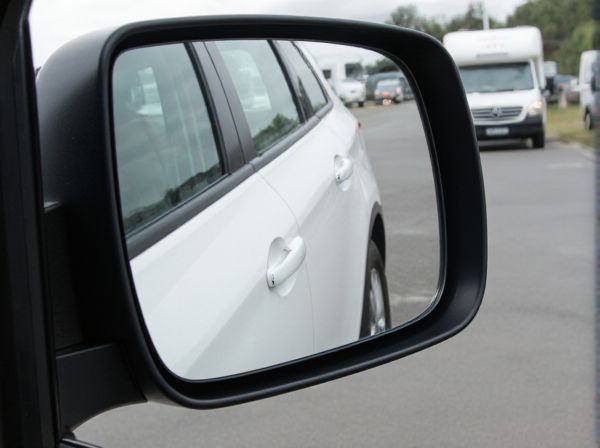
Photo illustration: Tow Mirror vs Standard Mirror
Tow mirrors provide enhanced visibility with a larger, wider field of view ideal for towing trailers or large loads, reducing blind spots and increasing safety. Standard mirrors offer a more compact design suited for everyday driving, focusing on convenience and aerodynamic efficiency. You should choose tow mirrors if you frequently haul heavy or oversized cargo to improve maneuverability and awareness on the road.
Table of Comparison
| Feature | Tow Mirror | Standard Mirror |
|---|---|---|
| Purpose | Designed for towing trailers and large loads | Standard rear visibility for everyday driving |
| Size | Larger with extended arms for wider field of view | Smaller and compact, fits close to vehicle body |
| Adjustability | Often manually or electronically extendable and adjustable | Fixed size with manual or electronic angle adjustment |
| Visibility Range | Enhanced side and rear visibility for towing safety | Standard visibility suitable for normal driving conditions |
| Installation | May require special mounting or adapters | Factory-installed or easy to replace |
| Cost | Higher due to size and towing features | Lower, standard equipment cost |
| Durability | Built to withstand towing stresses and vibrations | Designed for everyday wear and tear |
Introduction to Tow Mirrors vs Standard Mirrors
Tow mirrors provide extended visibility designed for towing larger trailers, improving safety by minimizing blind spots compared to standard mirrors. Standard mirrors are typically smaller with limited adjustment options, suitable for everyday driving without heavy hauling needs. Choosing between tow mirrors and standard mirrors depends on vehicle use, with tow mirrors enhancing rearward view during towing tasks.
Key Design Differences
Tow mirrors feature extended arms and larger reflective surfaces designed to improve visibility around wide or oversized loads, providing enhanced field of view crucial for towing trailers or heavy equipment. Standard mirrors have compact sizes with fixed positions, optimized for general driving conditions and close-range visibility without additional adjustments. The key design difference lies in tow mirrors' adjustability and size, which allow better rearward vision and reduce blind spots compared to the fixed, smaller standard mirrors.
Visibility and Blind Spots
Tow mirrors provide enhanced visibility by extending outward further than standard mirrors, allowing drivers to see around large trailers or vehicles. The wider field of view significantly reduces blind spots, improving safety during lane changes and reversing. Standard mirrors offer less coverage, often leaving larger blind spots that can hinder awareness on the road.
Safety Considerations
Tow mirrors provide enhanced visibility by extending outward, reducing blind spots and improving safety during towing or lane changes. Standard mirrors have limited field of view, which can increase the risk of accidents by obscuring nearby vehicles or obstacles. Choosing tow mirrors over standard mirrors significantly boosts awareness and safety for drivers transporting trailers or larger loads.
Installation and Compatibility
Tow mirrors typically require more complex installation processes, often involving additional brackets or wiring for features like power adjustment and heating, making them compatible mainly with specific truck and SUV models. Standard mirrors generally offer straightforward installation, designed to fit directly into a vehicle's existing mirror mount without extra modifications. Compatibility with the vehicle's make, model, and year is crucial for both types, but tow mirrors often demand precise matching due to their specialized size and functions.
Vehicle Types and Use Cases
Tow mirrors are specifically designed for larger vehicles such as trucks, SUVs, and RVs, providing extended visibility to accommodate wider trailers and heavy loads. Standard mirrors best suit compact cars and smaller passenger vehicles, offering streamlined design for everyday urban and highway driving. The choice between tow mirrors and standard mirrors depends largely on the vehicle's size and the necessity for enhanced blind spot coverage during towing or hauling.
Aerodynamics and Fuel Efficiency
Tow mirrors create increased aerodynamic drag compared to standard mirrors due to their larger size and extended positioning, negatively impacting fuel efficiency. Standard mirrors have a more streamlined shape, reducing air resistance and contributing to better miles per gallon (MPG) performance on highways. Choosing standard mirrors over tow mirrors can lead to noticeable fuel savings, especially during long-distance driving.
Cost Comparison
Tow mirrors generally cost between $100 and $300, making them more expensive than standard mirrors, which typically range from $20 to $80. Installation costs for tow mirrors can add $50 to $150 due to their larger size and mounting complexity, whereas standard mirrors often have minimal installation fees. Choosing between the two depends on the balance of budget constraints and the need for enhanced visibility while towing.
Maintenance and Durability
Tow mirrors feature heavy-duty construction with reinforced frames and weather-resistant coatings, significantly enhancing their durability compared to standard mirrors. Maintenance for tow mirrors involves regular cleaning of extended glass surfaces and hinge lubrication to prevent wear from frequent adjustments and vibrations during towing. Standard mirrors require less intensive upkeep due to smaller sizes and simpler mechanisms but may wear out faster under rough driving conditions.
Choosing the Right Mirror for Your Needs
Tow mirrors provide extended visibility and are ideal for towing trailers, offering enhanced safety and maneuverability compared to standard mirrors. Standard mirrors are compact and suitable for everyday driving with limited blind spots but lack the reach necessary for towing larger loads. Selecting the right mirror depends on vehicle type, towing requirements, and the need for expanded field of view to prevent accidents and improve driving confidence.
 caratoz.com
caratoz.com